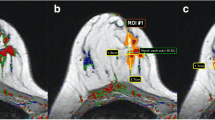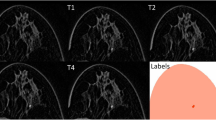Abstract
The discriminative ability of established diagnostic criteria for MRI of the breast is assessed, and their relative relevance using artificial neural networks (ANNs) is determined. A total of 89 women with 105 histopathologically verified breast lesions (73 invasive cancers, 2 in situ cancers, and 30 benign lesions) were included in this study. A T1-weighted 3D FLASH sequence was acquired before and seven times after the intravenous administration of gadopentetate dimeglumine at a dose of 0.2 mmol/kg body weight. ANN models were built to test the discriminative ability of kinetic, morphologic, and combined MR features. The subjects were randomly divided into two parts: a training set of 59 lesions and a verification set of 46 lesions. The training set was used for learning, and the performance of each model was evaluated on the verification set by measuring the area under the ROC curve (A z ). An optimally minimized model was constructed using the most relevant input variables that were determined by the automatic relevance determination (ARD) method. ANN models were compared with the performance of a human reader. Margin type, time-to-peak enhancement, and washout ratio showed the highest discriminative ability among diagnostic criteria and comprised the minimized model. Compared with the expert radiologist (A z =0.799), using the same prediction scale, the minimized ANN model performed best (A z =0.771), followed by the best kinetic (A z =0.743), the maximized (A z =0.727), and the morphologic model (A z =0.678). The performance of a neural network prediction model is comparable to that of an expert radiologist. A neurostatistical approach is preferred for the analysis of diagnostic criteria when many parameters are involved and complex nonlinear relationships exist in the data set.



Similar content being viewed by others
References
Heywang-Kobrunner SH, Viehweg P, Heinig A, Kuchler C (1997) Contrast-enhanced MRI of the breast: accuracy, value, controversies, solutions. Eur J Radiol 24:94–108
Rieber A, Brambs HJ, Gabelmann A, Heilmann V, Kreienberg R, Kuhn T (2002) Breast MRI for monitoring response of primary breast cancer to neo-adjuvant chemotherapy. Eur Radiol 12:1711–1719
Helbich TH (2000) Contrast-enhanced magnetic resonance imaging of the breast. Eur J Radiol 34:208–219
Kuhl CK (2000) MRI of breast tumors. Eur Radiol 10:46–58
Lucht RE, Knopp MV, Brix G (2001) Classification of signal–time curves from dynamic MR mammography by neural networks. Magn Reson Imaging 19:51–57
Vergnaghi D, Monti A, Setti E, Musumeci R (2001) A use of a neural network to evaluate contrast enhancement curves in breast magnetic resonance images. J Digit Imaging 14(2 Suppl. 1):58–59
Abdolmaleki P, Buadu LD, Naderimansh H (2001) Feature extraction and classification of breast cancer on dynamic magnetic resonance imaging using artificial neural network. Cancer Lett 171:183–191
Lucht R, Delorme S, Brix G (2002) Neural network-based segmentation of dynamic MR mammographic images. Magn Reson Imaging 20:147–154
Tzacheva AA, Najarian K, Brockway JP (2003) Breast cancer detection in gadolinium-enhanced MR images by static region descriptors and neural networks. J Magn Reson Imaging 17:337–342
Dayhoff JE, DeLeo JM (2001) Artificial neural networks: opening the black box. Cancer 91(8 Suppl.):1615–1635
Nunes LW, Schnall MD, Orel SG, Hochman MG, Langlotz CP, Reynolds CA et al (1999) Correlation of lesion appearance and histologic findings for the nodes of a breast MR imaging interpretation model. Radiographics 19:79–92
Ikeda O, Yamashita Y, Morishita S, Kido T, Kitajima M, Okamura K et al (1999) Characterization of breast masses by dynamic enhanced MR imaging. A logistic regression analysis. Acta Radiol 40:585–592
Kinkel K, Helbich TH, Esserman LJ, Barclay J, Schwerin EH, Sickles EA et al (2000) Dynamic high-spatial-resolution MR imaging of suspicious breast lesions: diagnostic criteria and interobserver variability. Am J Roentgenol 175:35–43
Heywang-Kobrunner SH, Bick U, Bradley WG Jr, Bone B, Casselman J, Coulthard A et al (2001) International investigation of breast MRI: results of a multicentre study (11 sites) concerning diagnostic parameters for contrast-enhanced MRI based on 519 histopathologically correlated lesions. Eur Radiol 11:531–546
Kristoffersen Wiberg M, Aspelin P, Perbeck L, Bone B (2002) Value of MR imaging in clinical evaluation of breast lesions. Acta Radiol 43:275–281
Rumelhart DE, Hinton GE, Williams RJ (1986) Learning representations by back-propagating errors. Nature 323:533–536
Neal RM (1996) Bayesian learning for neural networks, Lecture notes in statistics No. 118. Springer-Verlag, New York
Hanley JA, McNeil BJ (1983) A method of comparing the areas under receiver operating characteristic curves derived from the same cases. Radiology 148:839–843
Kaiser WA, Zeitler E (1989) MR imaging of the breast: fast imaging sequences with and without Gd-DTPA. Preliminary observations. Radiology 170:681–686
Fischer U, Kopka L, Grabbe E (1999) Breast carcinoma: effect of preoperative contrast-enhanced MR imaging on the therapeutic approach. Radiology 213:881–888
Leach MO (2001) Application of magnetic resonance imaging to angiogenesis in breast cancer. Breast Cancer Res 3:22–27
Knopp MV, Weiss E, Sinn HP, Mattern J, Junkermann H, Radeleff J et al (1999) Pathophysiologic basis of contrast enhancement in breast tumors. J Magn Reson Imaging 10:260–266
Wedegartner U, Bick U, Wortler K, Rummeny E, Bongartz G (2001) Differentiation between benign and malignant findings on MR-mammography: usefulness of morphological criteria. Eur Radiol 11:1645–1650
Arana E, Marti-Bonmati L, Bautista D, Paredes R (1998) Calvarial eosinophilic granuloma: diagnostic models and image feature selection with a neural network. Acad Radiol 5:427–434
Abe H, Ashizawa K, Katsuragawa S, MacMahon H, Doi K (2002) Use of an artificial neural network to determine the diagnostic value of specific clinical and radiologic parameters in the diagnosis of interstitial lung disease on chest radiographs. Acad Radiol 9:13–17
Lo JY, Baker JA, Kornguth PJ, Floyd CE Jr (1995) Computer-aided diagnosis of breast cancer: artificial neural network approach for optimized merging of mammographic features. Acad Radiol 2:841–850
Nunes LW, Schnall MD, Orel SG (2001) Update of breast MR imaging architectural interpretation model. Radiology 219:484–494
Baum F, Fischer U, Vosshenrich R, Grabbe E (2002) Classification of hypervascularized lesions in CE MR imaging of the breast. Eur Radiol 12:1087–1092
Author information
Authors and Affiliations
Corresponding author
Rights and permissions
About this article
Cite this article
Szabó, B.K., Wiberg, M.K., Boné, B. et al. Application of artificial neural networks to the analysis of dynamic MR imaging features of the breast. Eur Radiol 14, 1217–1225 (2004). https://doi.org/10.1007/s00330-004-2280-x
Received:
Revised:
Accepted:
Published:
Issue Date:
DOI: https://doi.org/10.1007/s00330-004-2280-x




